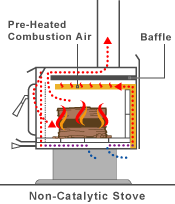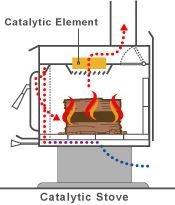Choosing the Right Wood-Burning Stove
- Emission limits for wood stoves
- Types of wood stoves
- Finding the right size and model
- Additional resources for choosing a wood stove
Today’s wood stove models feature improved safety and efficiency--they produce almost no smoke, minimal ash, and require less firewood. While older uncertified stoves release 15 to 30 grams of smoke per hour, new EPA-certified stoves produce no more than 4.5 grams per hour. Look for the EPA certification label on the back of the stove, or check the current list of EPA-certified wood stoves. Also check for safety labelling by the Underwriters' Laboratories of Canada (ULC) or another testing and certification body.
Emission Limits for Wood Stoves
Stove manufacturers have improved their combustion technologies over the years, and now some newer stoves have certified emissions in the 1 to 4 g/h range. When comparing models, look for the EPA white label on the stove - a lower g/h rating means a cleaner, more efficient wood stove.
Learn more about wood stove regulations.Types of Wood Stoves
The two general approaches to meeting the EPA smoke emission limits are non-catalytic and catalytic combustion. Both approaches have proved effective, but there are performance differences. Although most of the stoves on the market are non-catalytic, some of the more popular high-end stoves use catalytic combustion. Because they are slightly more complicated to operate, catalytic stoves are suited to people who like technology and are prepared to maintain the stove properly so it continues to operate at peak performance.
Non-catalytic stoves
Catalytic stoves
All catalytic stoves have a lever-operated catalyst bypass damper which is opened for starting and reloading. The catalytic honeycomb degrades over time and must be replaced, but its durability is largely in the hands of the stove user. The catalyst can last more than six seasons if the stove is used properly; but if the stove is over-fired, inappropriate fuel (like garbage and treated wood) is burned, and if regular cleaning and maintenance are not done, the catalyst may break down in as little as 2 years. (EPA note: Garbage should never be burned in a wood stove or fireplace.)
Finding the Right Size and Model
When choosing a wood stove, consider the size of the space you'll be heating. Wood stoves come in different sizes, and can be sized to heat a single room or an entire home.
- Small stoves are suitable for heating a family room or a seasonal cottage. In larger homes with older central furnaces, you can use a small stove for "zone heating" a specific area of your home (family or living room). This can reduce fuel consumption, conserve energy and save you money while maintaining comfort.
- Medium stoves are suitable for heating small houses, medium-sized energy-efficient houses, and cottages used in winter.
- Large stoves are suitable for larger, open plan houses or older, leakier houses in colder climate zones.
EPA maintains a database of EPA-certified wood heaters. However, it's best to talk with experienced hearth product retailers who know the performance characteristics of the products they sell. When visiting local retailers, take along a floor plan of your home; knowledgeable retailers can help you find a wood stove, fireplace insert, or other hearth product that is well suited to the space you want to heat.
If you're trying to determine if your current wood stove is EPA certified under EPA regulations, look for the permanent metal EPA certification label on the back of the stove, or you can check to see if your model is listed in the current database of EPA-certified wood heaters.
Additional Resources for Choosing a Wood Stove
- Alliance for Green Heat - Information to consider when purchasing a wood stove.
- Hearth.com - A comprehensive website that will help you find most any hearth product you are looking for and/or address any of your hearth questions.
- How much heat does that room need? - Allows consumers to estimate the amount of BTUs required to heat a room by entering in the room’s dimensions.


